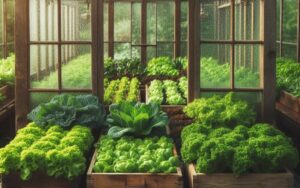
The secrets of what to grow in a greenhouse gardening with our guide on what to grow in your greenhouse. From tomatoes and cucumbers to peppers and aromatic herbs, explore a variety of plants suited for greenhouse cultivation. Maximize your harvest and create a thriving oasis of fresh produce year-round
I’m Mitch from New Zealand, a country known for its stunning landscapes and diverse climates. Around here, we experience everything from the frosty winters down in Otago to the warm, humid summers up in Northland. And if you’re as passionate about gardening as I am, you know that these fluctuations can be quite a challenge for growing plants outdoors where ever you maybe in the world.
That’s where the magic of greenhouse gardening comes in. It’s a game-changer, providing a stable environment where plants can thrive regardless of external weather conditions. I’ve seen first-hand how a greenhouse can transform the gardening experience, offering a sanctuary for a wide array of plants that would otherwise struggle in New Zealand’s capricious weather.
But it’s not just for those with years of dirt under their fingernails. Both amateur and seasoned gardeners can reap the benefits of a greenhouse, including an extended growing season and the joy of harvesting your very own produce. Moreover, practicing greenhouse gardening aligns with safety and sustainability, as it allows us to minimize chemical use and control water consumption more effectively.
I’ll take you through the ins and outs of what to grow in your very own greenhouse. Whether you’re nestled in the cooler climes of the deep south or basking in the subtropical north, you’re going to find out about the variety of plants that don’t just survive but actually flourish under glass. Lets dive into what to grow in a green house.
Choosing the Right Plants for Your Greenhouse
So, you’ve got your greenhouse ready to go. The next big question is, what do you grow in it? It’s not just about throwing in seeds and hoping for the best; you’ve got to play matchmaker between your plants and their new climate-controlled home.
First up, let’s get our heads around the greenhouse environment. It’s like a cozy little bubble where you control the weather. You get a say in the temperature, the humidity, and how much sunlight your greens soak up. Before you start imagining tropical jungles or desert oases, though, it’s essential to learn which plants actually do well under your watchful eye.
If you want a pro tip, ask someone who’s been there. That’s me, Mitch, and I’m here to share some insights from the beautiful, albeit unpredictable, climes of New Zealand. The plants I swear by? For veggies, we’re talking tomatoes, cucumbers, chillies, peppers and leafy greens. They love the balanced climate of the greenhouse. Fruit-wise, strawberries are a winner, and flowers? A greenhouse can be a haven for blossoms like begonias and geraniums.
I can’t stress enough the value of a good seasonal planting guide, tailored for greenhouse enthusiasts. It helps you decide what to plant and when, so you’re not just guessing. You’ll know when to roll out the welcome mat for your spring seedlings or prep for the cool-season crops.
For more info on greenhouses check out this article
Techniques for Successful Greenhouse Cultivation
Now, if you’re like me, you’re probably eager to dive right in and get your greenhouse bustling with life. But wait up, getting those greens to thrive takes a bit more than just enthusiasm. You’ve got to get your hands dirty with some tried-and-true cultivation techniques. And don’t worry, I’ve got some tips that’ll have you growing like a pro in no time.
First up, let’s talk dirt, or more specifically, soil. Good soil is like a good home for your plants – it needs the right balance to make sure your greens stay happy. You’re going to want to focus on soil quality, proper aeration, and nutrition. Choose a high-quality potting mix or make your own blend – a mixture of garden soil, compost, and perlite is my go-to.
Water – it’s crucial, but like with any good thing, too much or too little can spell disaster. You’ll want a watering routine that’s just right. Over in my New Zealand greenhouse, I’ve set up a drip irrigation system that keeps the moisture levels optimal. Trust me, it’s a game-changer. And remember, some plants need more water than others; it’s all about balance.
Nobody likes uninvited guests, especially if they’re of the creepy-crawly variety. In my experience, it’s best to go natural with pest control. Use ladybugs to battle aphids or introduce beneficial nematodes to take care of soil pests. It’s like setting up a tiny, bug-sized neighborhood watch.
Finally, keeping an eye on your greenhouse’s climate is crucial. Your plants are picky about temperature and airflow. Setting up a thermometer and hygrometer to monitor these conditions will help a lot. For those chilly New Zealand nights, you might need a heater, but remember, proper ventilation during the day is just as important for preventing disease and promoting growth.

Overcoming Common Greenhouse Challenges
Even in an environment as controlled as a greenhouse, challenges do pop up. You’re going to find out about some of the most common ones and how to tackle them effectively.
Space can be at a premium inside a greenhouse. It’s important to maximize the use of available area without compromising plant health. This means strategic planning for plant spacing, vertical gardening, and adaptable shelving. These methods not only improve air circulation but also enhance sunlight exposure to each plant.
Plant diseases can wreak havoc in the humid, warm conditions of a greenhouse. Creating an environment less conducive to disease involves proper airflow, cleanliness, and crop rotation practices. Regularly inspecting your plants for any signs of distress is crucial. I’ve learned from experience that early detection is key to managing outbreaks.
Choosing the right plants to grow can be tricky. Some might flourish while others struggle. Don’t worry too much about it—this is a learning curve. Documenting which species thrive and which do not, and adjusting your approach based on those notes is the strategy I like to leverage. Plus, it’s always invigorating to experiment with new varieties.
While these issues might seem daunting, remember that technology and innovation are on your side. Advances in greenhouse equipment, such as automated watering systems and climate control tools, make it easier to maintain an optimal growing environment. Mitch from New Zealand found that integrating smart technology into his greenhouse not only increased his plants’ yield but also made management more convenient.
Beyond the Greenhouse: Engaging the Gardening Community
I’m going to wrap this up by talking about how a greenhouse does more than just nurture plants; it can also cultivate a sense of community. From my own journey as Mitch from New Zealand, I found a vibrant community of like-minded individuals passionate about greenhouse gardening.
If you want to expand your gardening horizons, consider reaching out to local gardening clubs or online forums. Sharing insights and swapping stories with fellow enthusiasts reinforces the joy of gardening.
In my opinion, educational resources such as workshops and seminars are gold mines for up-skilling and staying ahead in the greenhouse game. Do check out what’s available in your area or online.
Choose to get involved; your experience can benefit others just starting out. Plus, you can always adjust your approach down the road based on the collective wisdom of the community.
I really hope that you find engaging with the gardening community as enriching as I do. Remember, growing in a greenhouse is not just about harvesting produce; it’s also about harvesting relationships and knowledge.
Leave us a comment
Happy gardening
Mitch
Follow to stay up to date with new posts!

Our website contains affiliate links. This means if you click and make a purchase, we may receive a small commission. Don’t worry, there’s no extra cost to you. It’s a simple way you can support our mission to bring you quality Gardening Tips.

